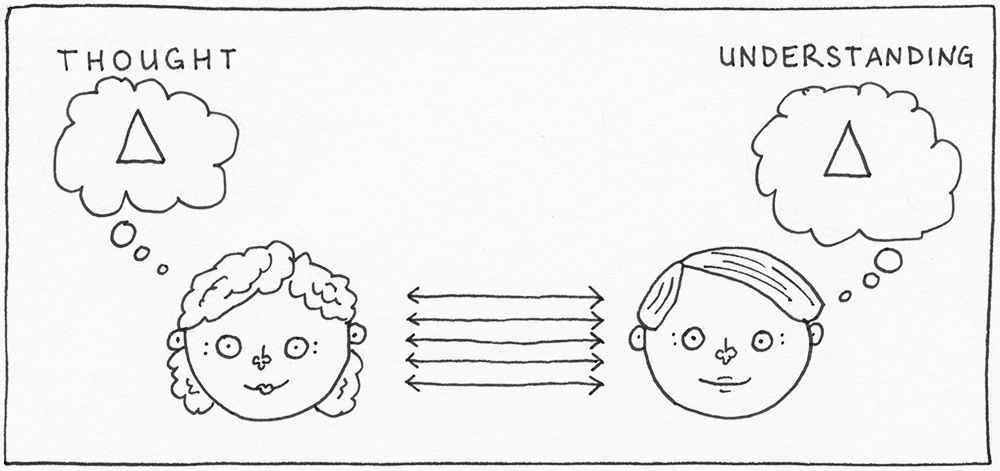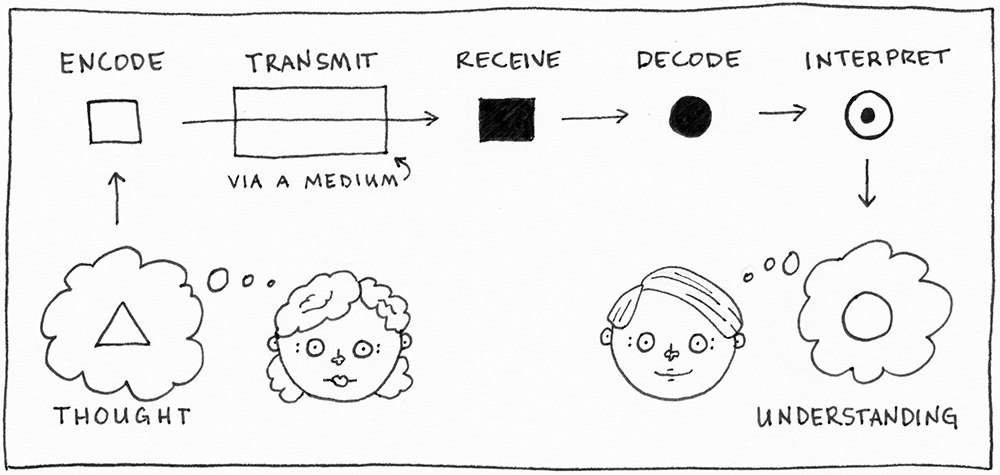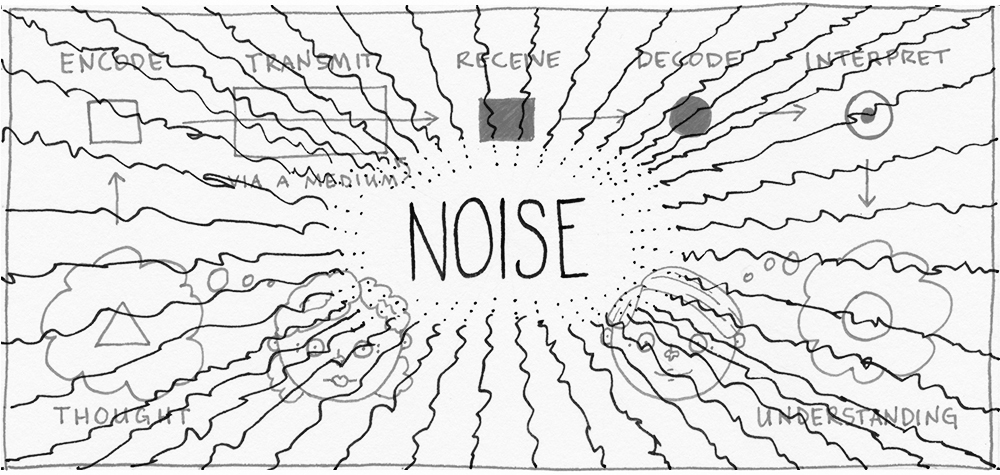I used to think I was good at communication. You probably think, like I once did, you’re clear when you talk to people at work (or email or text them), and it’s easy for them to understand exactly what you mean.
And you’d be utterly, completely wrong.
Communicating is the most important thing in our lives and the hardest thing for us to do well. Transferring information from one person to another via any path will always be inherently difficult and fraught with danger… or it will until we have the Vulcan mind meld (haha!). But honestly, I don’t want you touching my face. So I propose we find another way to negotiate this obstacle course.
I used to think I was good at communication. What do I think now? Well, now I know I suck at it. I’m here to convince you that you suck at communicating, too. We all do. We’re in this pickle together.
The good news is, there are simple things we can do to improve communication, particularly in the workplace. But before we get to that, let’s understand why we suck at it right now.
Three reasons everyone sucks at communicating
1. We think we know how communication works, and we’re wrong
The first reason we suck at communicating is that we are very, very, very wrong about how communication works. Communication is not “a thought in my brain becomes an understanding in your brain.”

No matter how we transfer the message “triangle,” we think it’s easy for our recipient to understand “triangle.” Well, at least we think they should easily understand “triangle,” which brings me to…
2. When communication fails, we blame everyone but ourselves
When recipients don’t understand our message, we often fault them. Why weren’t they listening? Didn’t they read my document? Why didn’t they pay more attention? Are they just not smart enough to understand what I was saying? Were we not in the same &%$*@ meeting?! They should know about this because they got the same email everyone else did!
When you blame your coworker for a communication breakdown, you don’t feel responsible for fixing things, or even feel like you can fix them. But when you know how communication actually works, things become more clear, so let’s look at that next.
3. The way communication works is crazy-complex
(This is the most fiddly, info-packed part of this article. I tried to stick to the basics, but even so, it is still a lot to take in. Don’t skip it or scan it because if you understand the problem, the strategies for improving communication will make more sense to you.)
When I took a class in project communications management I was introduced to a model of how we communicate that blew my mind and completely changed how I exchange information with my fellow humans. I know that sounds like hyperbole, but it’s not. That moment was a true epiphany for me that filled my chest with light, joy, and shimmering butterflies of hope which are still alive and flitting about. They are the whole reason I’m writing this. I believe that sharing this information could make the world a better place, if not for everyone, at least for the people who know it.
Below is my slightly modified version of that model. (I added “interpret” as a step because I feel like that’s a separate action from “decode” and another place where miscommunication is possible.)
Simply put, communication between Human 1 and Human 2 is: thought >> encode >> transmit >> receive >> decode >> interpret >> understanding

Haha, ok, so that’s not very simple, but neither is communication. I’m going to resist the impulse to unpack each step because the article would double in length. Instead, let’s look at an example:
- Thought: I have a vague feeling of hunger and a desire for something tasty.
- Encode: I write a message on Slack, “I’m so hungry.”
- Transmit: I drop that message with a Cookie Monster gif into my team’s Slack channel.
- Receive: People on my team get a message indicator on Slack.
- Decode: My teammates read it and see my gif.
- Interpret: One person thinks I want cookies. One person sees it’s 11:30am in San Francisco and assumes I’m ready for lunch. One person thinks I’m obsessed with Cookie Monster gifs because it’s the fourth one I’ve posted in three hours.
- Understanding: One person thinks I have a sweet tooth. One person thinks I should probably eat a bigger breakfast. One person wonders where I find all of these amazing gifs.
See? There’s a lot going on, even in the simplest of information exchanges.
If you have sharp eyes, you noticed the message in my diagram changes from step to step, the triangle becomes a square which becomes… a bunch of different shapes… and ends up a circle. That’s because there is one element missing from that diagram which I’ll add now: noise.

By adding noise, a complicated thing becomes 800% more complicated. In this context, noise means a disturbance or interference with our communication system at any point.
Examples of noise during communication:
- The emotional state of the participants (e.g., angry, happy, sad).
- The relationship between the participants (e.g., siblings, married couples, coworkers).
- The expectations of the participants (e.g. you assume positive intent, they expect bad news).
- The context of the participants (e.g. confused, busy, distracted, impatient, underprepared, biased).
- The language abilities of the participants (e.g., you don’t know the language of the speaker).
- The capabilities of your transmission medium (e.g., unreadable handwriting, bad wifi for video calls).
- Literal noise (e.g, the cafe where you’re talking is crowded and loud).
I am not joking when I say that I’m shocked that we ever successfully communicate anything at all.
“I give up, Alice. Let’s all go live in off-the-grid cabins deep in the woods.”
I am right there with you! This is literally my dream, but I’ve been told the world will grind to a halt if we all do that, so let’s consider other options. Luckily, I have some ideas to share with you.
Strategies to improve your communication in the workplace
Here are ten strategies to help you when your communications are falling apart – which, as we’ve seen, is a constant occurrence. Some of us need help in one area, some in another. Choose the strategies that will help you and your coworkers. Personally, I strive to practice all of these.
Expect communication breakdowns and view them as opportunities to refine your message
When someone misunderstands you, it’s easy to get frustrated or even angry, but if you’re ready for it, if you’re waiting for that moment when it all falls apart, you feel excitement and think, “Yes! Now I can try and fix this!” instead of, “Gah, how many times do I need to repeat myself?!”
Feel responsible and accountable for your communications being successful
There is a difference between being at fault or to blame and being responsible and accountable. To use the example from the book The Subtle Art of Not Giving a F*ck, if someone leaves a baby on your doorstep, you aren’t to blame for the baby’s abandonment, but you are responsible for your actions once you find the baby. Fault and blame are in the past while responsibility and accountability are in the present. When your communications are not understood as you intend, for any reason, you should feel responsible for helping your recipients close that gap.
Tailor your message and your medium to your audience
This means understanding who you’re communicating with, their context, and the potential noise the message will encounter, and using that knowledge to modify the words and medium you choose to account for that. A little empathy for your colleagues can go a long way.
Tell a story
If I walk into a project kickoff meeting, assign tasks to each person, and then promptly walk out of the meeting, I will leave behind a group of baffled coworkers. To have a successful project, you need everyone to know the story of the project: its timeline, how tasks are broken down, which tasks are dependent on others, who is driving the project, how we’ll communicate throughout the project, and what the goal of the project is.
It’s the same for any other kind of communication. We are not robots. We are humans and we like to understand what’s going on. Craft a narrative that includes all of the relevant details when communicating to help your teammates understand. This could be as simple as reviewing your agenda at the start of a meeting or as involved as a 30-minute keynote presentation outlining your 3-year product strategy.
Ask for follow up
Don’t wait for your coworkers to confirm receipt of your message. I call that “throwing things over the fence and running away.” Whenever you hear someone at work say, “Well, so-and-so never got back to me,” you can bet it’s a throw-it-over-the-fence situation. When you send a message, include what marketing folks refer to as a “call to action” (a.k.a. CTA). Examples of CTAs are: “Let me know what you think,” “I’ll check back with you on Tuesday if I don’t hear from you by then,” or “I need to know the answer by Friday otherwise we can’t hit our deadline.”
Not only is a CTA going to help nudge people to respond, but it also lets them know what kind of follow up is expected. People could get your message and not know whether it’s an FYI, a request for approval, or a warning. When you tell people what you need from them, it is easier for them to reply. Of course, some people still fail to respond and you are responsible for reaching out to them, but including a CTA usually prompts a response.
Ask for feedback
Don’t wait for your coworkers to confirm their understanding of your message, either. Ask for feedback. Ask questions like, “What words would you use to say that?” or “Can you tell me what that means to you?” The key is to have them articulate their understanding so you can listen for points where your message and their understanding diverge. If you simply ask, “Do you understand?” and get a “Yes” in return you do not know whether or not they really did.
Get curious
When you find points of disconnection, don’t simply repeat your message. If it didn’t get through the first time, it probably won’t work the second time (ask me how I know – LOL!). Instead, start asking questions. Questions are a great way to learn or to help others learn. Some of my favorites are:
- “Can you tell me more about that?”
- “Are there any other options we should consider?”
- “Can you help me understand where you’re coming from?”
- “What part do you agree with?”
- “What part do you disagree with?”
- “Do we have all the information we need?”
Listen
Seriously. Be quiet and attentive and listen. Don’t read your email and listen. Don’t respond to a Slack message and listen. Don’t peek at your Apple Watch and listen. Don’t imagine stabbing them in the face with a fork and listen. Don’t prepare your response and listen. Just listen. You can’t learn what the other person is thinking if you don’t listen.
Stop interrupting
Even when you think you know exactly what they’ll say, do not interrupt. Zip it. Let people finish what they are saying. For one thing, maybe you’re wrong. For another thing, if you cut them off, they aren’t listening to you. Instead, they are waiting for a chance to finish what they were saying.
Interrupting doesn’t save time. It makes things take longer.
Worse yet, interrupting could make them lose their train of thought completely. Interrupting doesn’t save time. It makes things take longer. Constantly interrupting others makes your conversations suck.
Be tenacious
Your new communication motto should be “can’t stop, won’t stop”. Often in workplace conversations, I hear people try to employ these strategies and give up before they succeed. Most of my job is literally communication in one form or another, so I know how frustrating (oh. so. frustrating…) it can get when someone doesn’t understand what you’re saying. But don’t give up.
Keep at it until you’re sure you’ve achieved your goal. Patience is a virtue here. Imagine yourself working your way through the noise toward the other person with your message, as if delivering the mail in a raging snowstorm. Sometimes it takes way more effort than seems reasonable, but if you stop partway there, then all of your efforts were for naught.
Here’s to workplace communication that doesn’t suck
All right. Hopefully by this point…
- I convinced you that you’re terrible at communicating, especially in the workplace.
- You understand why all of us are terrible at communicating.
- You have some strategies for engaging in this eternal and universal struggle.
If that’s where you are, then I have been successful!
One last request: if you have any feedback about this article, I would love to hear it. If you have any other strategies for improving communication, please share them. If you want to talk about this more, I would really enjoy that, so reach out to me.









































